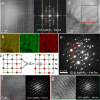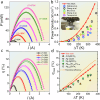Realizing high power factor and thermoelectric performance in band engineered AgSbTe2
- PMID: 39746968
- PMCID: PMC11696114
- DOI: 10.1038/s41467-024-55280-0
Realizing high power factor and thermoelectric performance in band engineered AgSbTe2
Abstract
AgSbTe2 is a promising p-type thermoelectric material operating in the mid-temperature regime. To further enhance its thermoelectric performance, previous research has mainly focused on reducing lattice thermal conductivity by forming ordered nanoscale domains for instance. However, the relatively low power factor is the main limitation affecting the power density of AgSbTe2-based thermoelectric devices. In this work, we demonstrate that hole-doped AgSbTe2 with Sn induces the formation of a new impurity band just above the valence band maximum. This approach significantly improves the electrical transport properties, contrary to previous strategies that focused on reducing lattice thermal conductivity. As a result, we achieve a record-high power factor of 27 μWcm-1K-2 and a peak thermoelectric figure of merit zT of 2.5 at 673 K. This exceptional performance is attributed to an increased hole concentration resulting from the formation of the impurity band and a lower formation energy of the defect complexes ( + ). Besides, the doped materials exhibit a significantly improved Seebeck coefficient by inhibiting bipolar conductivity and preventing the formation of n-type Ag2Te. Additionally, the optimized AgSbTe2 is used to fabricate a unicouple thermoelectric device that achieves energy conversion efficiencies of up to 12.1% and a high power density of 1.13 Wcm-2. This study provides critical insights and guidance for optimizing the performance of p-type AgSbTe2 in thermoelectric applications.
© 2024. The Author(s).
Conflict of interest statement
Competing interests: One Chinese patent application (202410992695X) was filed by Y.Z. and T.Z. The remaining authors declare no competing interests.
Figures





References
-
- Bell, L. E. Cooling, heating, generating power, and recovering waste heat with thermoelectric systems. Science321, 1457–1461 (2008). - PubMed
-
- Goldsmid, H. J. Introduction to thermoelectricity. Vol. 121 (Springer, 2010).
-
- Shi, X.-L., Zou, J. & Chen, Z.-G. Advanced thermoelectric design: from materials and structures to devices. Chem. Rev.120, 7399–7515 (2020). - PubMed
-
- Tan, G., Zhao, L.-D. & Kanatzidis, M. G. Rationally designing high-performance bulk thermoelectric materials. Chem. Rev.116, 12123–12149 (2016). - PubMed
-
- Snyder, G. J. & Toberer, E. S. Complex thermoelectric materials. Nat. Mater.7, 105–114 (2008). - PubMed
Grants and funding
- No. G20240034 and No. G20240041/Wenzhou Municipal Science and Technology Bureau (Wenzhou Municipal Sci - Tech Bureau)
- No. 12204156/National Natural Science Foundation of China (National Science Foundation of China)
- No. 22208293/National Natural Science Foundation of China (National Science Foundation of China)
- No. 2023TQ0315 and 2023M743224/China Postdoctoral Science Foundation
LinkOut - more resources
Full Text Sources
Research Materials

